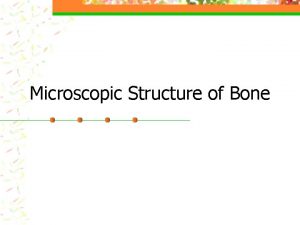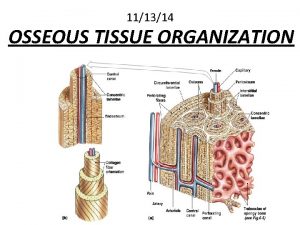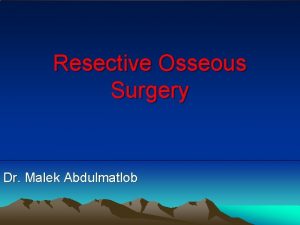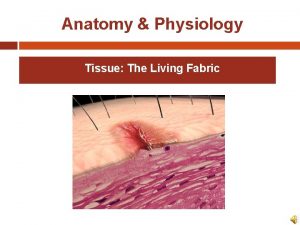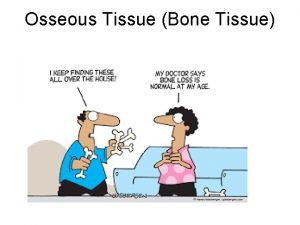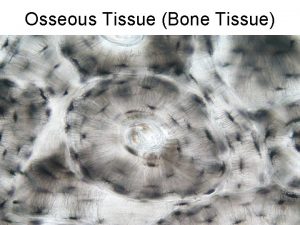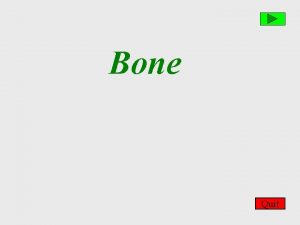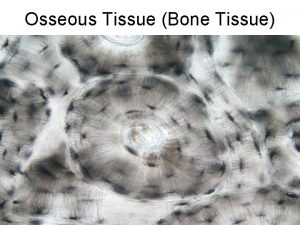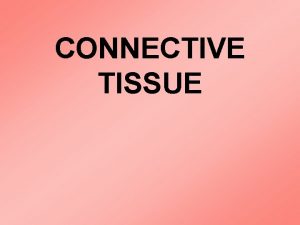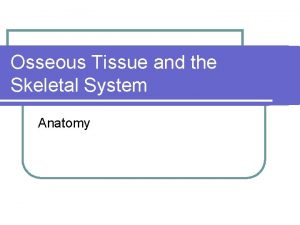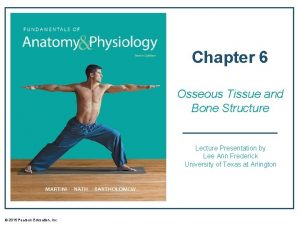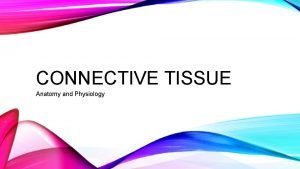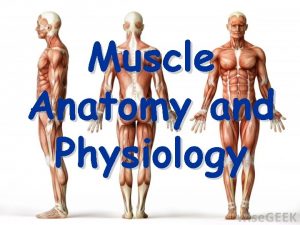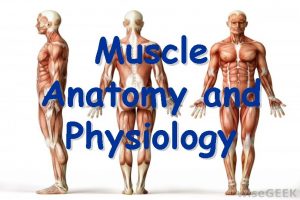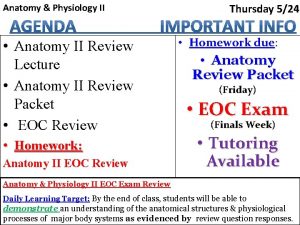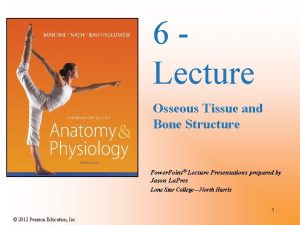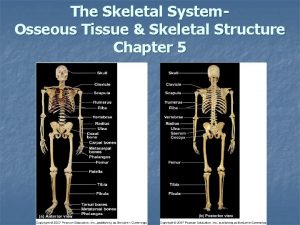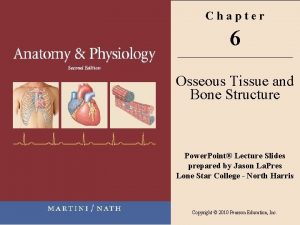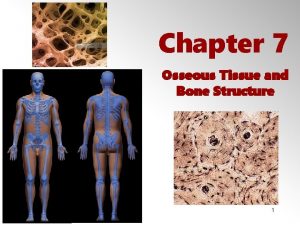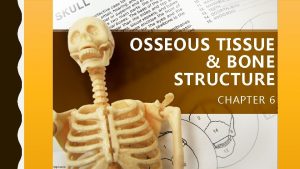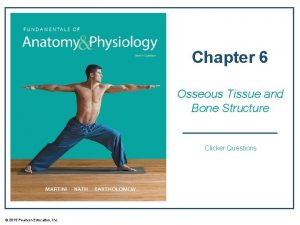Anatomy Physiology Lecture 6 Chapter 6 Osseous Tissue





































- Slides: 37

Anatomy & Physiology Lecture 6 : Chapter 6 Osseous Tissue and Skeletal Structure Pages: 179 - 204 Lecturer: Dr. Barjis Room P 313 / P 307 Phone: (718) 260 -5285 E-Mail: ibarjis@citytech. cuny. edu Copyright © 2004 Pearson Education, Inc. , publishing as Benjamin Cummings Frederic H. Martini Fundamentals of

Learning Objectives • Describe the functions of the skeletal system. • Classify bones and identify the major markings. • Identify cell types in bone and list their functions. • Compare spongy and compact bone. • Compare intramembranous and endochondral ossification. • Discuss the effects of nutrition, hormones, exercise and aging on the bones. • Describe the types of fractures.

The skeletal system includes • Bones of the skeleton • Cartilages, ligaments and other connective tissues that stabilize and connect

Functions of the skeletal system • Support • Storage of minerals and lipids • Blood cell production • Protection • Leverage

A Classification of Bones Bone shapes • Long • Flat • Short • Irregular • Sesamoid • Sutural

Classification of Bones by Shape

Bone structure = two types of bone • Compact bone (dense) • Spongy bone (cancellous)

Bone Histology Osseous tissue • Supporting tissue with a solid matrix • Crystals of hydroxyapatite • Minerals deposited in lamellae • Covered by periosteum

Cells in bone: • Osteocytes = mature bone cells • In lacunae • Connected by canaliculi • Osteoblasts synthesize new matrix • Osteogenesis • Osteoclasts dissolve bone matrix • Osteolysis • Osteoprogenitor cells differentiate into osteoblasts

The Histology of Compact Bone

The Histology of Compact Bone

Compact bone and spongy bone • Basic unit of compact bone is an osteon • Osteocytes arranged around a central canal • Perforating canals extend between adjacent osteons • Spongy bone contains trabeculae

The Structure of Osseus Tissue

Bones and stress • Compact bone located where stresses are limited in direction • Spongy bone located where stresses are weaker or multi-directional

The Distribution of Forces on a Long Bone

Bones are: • Covered by periosteum • Lined by endosteum Animation: Axial Dissections (check the animations)

Bone development and growth • Ossification = converting other tissue to bone • Calcification = depositing calcium salts within tissues

Intramembranous ossification • Begins with osteoblast differentiation • Dermal bones produced • Begins at ossification center

Intramembranous Ossification

Endochondral ossification • Cartilage model gradually replaced by bone at metaphysis • Increasing bone length • Timing of epiphyseal closure differs • Appositional growth increases bone diameter

Endochondral Ossification

Endochondral Ossification Animation: Endochondral Ossification (Check animations)

Bone Growth at an Epiphyseal Cartilage

Appositional Bone Growth

Appositional Bone Growth

The Circulatory Supply to a Mature Bone

The Dynamic Nature of Bone continually changing • Remodeling • Exercise • Hormone levels • Growth hormone and thyroxine increase bone mass • Calcitonin and PTH control blood calcium levels

A Chemical Analysis of Bone

The skeleton is a calcium reserve • 99% body’s calcium in the skeleton • Calcium ion concentration maintained by bones GI tract and kidneys • Calcitonin and PTH regulate blood calcium levels • Calcitonin decreases blood calcium levels • PTH increases blood calcium levels

Factors that Alter the Concentration of Calcium Ions in Body Fluids

Factors that Alter the Concentration of Calcium Ions in Body Fluids

Fracture repair • Fracture hematoma • External callus • Internal callus

Steps in the Repair of a Fracture

Bone Markings (Surface Features) Bone markings • Are characteristic for each bone and each individual • Markings include • Elevations • Projections • Depressions • Grooves and tunnels

Aging and the Skeletal System Effects of aging include • Osteopenia • Osteoporosis

The Effects of Osteoporosis

You should now be familiar with: • The functions of the skeletal system. • Bones and their major markings. • Cell types in bone and their functions. • Spongy and compact bone. • Intramembranous and endochondral ossification. • The effects of nutrition, hormones, exercise and aging on the bones. • The types of fractures.
 Bone cell
Bone cell Chapter 14 anatomy and physiology
Chapter 14 anatomy and physiology Waistline
Waistline Anatomy and physiology chapter 8 special senses
Anatomy and physiology chapter 8 special senses Chapter 13 anatomy and physiology of pregnancy
Chapter 13 anatomy and physiology of pregnancy Anatomy and physiology chapter 2
Anatomy and physiology chapter 2 Heat and cold
Heat and cold Art labeling activity: figure 14.1 (3 of 3)
Art labeling activity: figure 14.1 (3 of 3) Chapter 10 blood anatomy and physiology
Chapter 10 blood anatomy and physiology Anatomy and physiology chapter 15
Anatomy and physiology chapter 15 Anatomy and physiology chapter 1
Anatomy and physiology chapter 1 Holes anatomy and physiology chapter 1
Holes anatomy and physiology chapter 1 Gi tract histology
Gi tract histology Chapter 1 introduction to anatomy and physiology
Chapter 1 introduction to anatomy and physiology Chapter 2 human reproductive anatomy and physiology
Chapter 2 human reproductive anatomy and physiology Anatomy and physiology chapter 8 skeletal system
Anatomy and physiology chapter 8 skeletal system Chapter 6 general anatomy and physiology
Chapter 6 general anatomy and physiology Cranial cephalic
Cranial cephalic Microbial physiology and metabolism lecture notes
Microbial physiology and metabolism lecture notes 01:640:244 lecture notes - lecture 15: plat, idah, farad
01:640:244 lecture notes - lecture 15: plat, idah, farad Upper respiratory diagram
Upper respiratory diagram Tattoo anatomy and physiology
Tattoo anatomy and physiology Anatomy science olympiad
Anatomy science olympiad Structure anatomy and physiology in agriculture
Structure anatomy and physiology in agriculture Anatomy and physiology of bone
Anatomy and physiology of bone Triple therapy for peptic ulcer disease
Triple therapy for peptic ulcer disease Segmental anatomy of the liver
Segmental anatomy of the liver Difference between anatomy and physiology
Difference between anatomy and physiology Wpigastric region
Wpigastric region Anatomy and physiology blood
Anatomy and physiology blood Human anatomy and physiology seventh edition marieb
Human anatomy and physiology seventh edition marieb Http://anatomy and physiology
Http://anatomy and physiology Physiology of appendicitis
Physiology of appendicitis Aohs foundations of anatomy and physiology 1
Aohs foundations of anatomy and physiology 1 Aohs foundations of anatomy and physiology 2
Aohs foundations of anatomy and physiology 2 Anatomy and physiology of swine
Anatomy and physiology of swine Unit 26 animal anatomy physiology and nutrition
Unit 26 animal anatomy physiology and nutrition Science olympiad forensics cheat sheet
Science olympiad forensics cheat sheet
